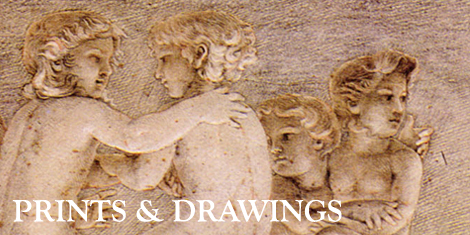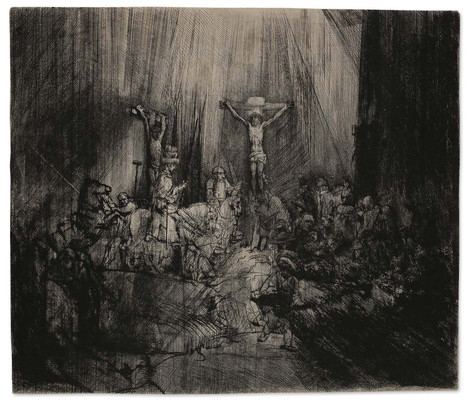
THE CRUCIFIXION IN FOUR VERSIONS
Rembrandt Harmensz. van Rijn
The Three Crosses, 1653 or c. 1661
Like almost no other artist, Rembrandt was in the habit of continually revising printing plates he had already completed. Doubtless the most striking example of such a makeover in his graphic work is the large-format print The Three Crosses, of which four versions are known. The Cologne sheet depicts the fourth (and final) version. The work is almost entirely in drypoint, a technique in which the artist scores lines directly into a metal plate (usually copper) using a sharp metal stylus. This altogether drawing-like process creates a burr alongside the scored line, albeit one which soon wears down with repeated inking and removal of the sheets during the printing process. After Rembrandt had already signed the third version of the plate, together with the date 1653, thus clearing it for sale, in about 1661 he reworked the plate yet again. In places it was ground smooth, so that further changes to the composition could be made using a drypoint needle and a burin.
Depicted is the moment of Christ’s death on the Cross (Luke 23, 33–49). Darkness falls over the land, and the crucified Christ calls out: ‘Father, into thy hands I commend my spirit.’ Rembrandt has composed the event as a panorama of shock and terror, in the centre of which the suffering Christ appears in majestic calm. Round about are further groups of people crowded together, including the Virgin Mary, sinking to her knees in a faint, St John, and Mary Magdalene. Many of the figures are only sketchily indicated, while by contrast Rembrandt treats the lighting with great intensity: darkness is indicated by vertical hatching spread over the whole picture.
Rembrandt Harmensz. van Rijn
Leiden 1606 – 1669 Amsterdam
The Three Crosses
4th version, 1653 or c. 1661, drypoint and engraving on vergé paper, 38.5 x 45 cm
Acquired in 1938
WRM 1938/64



